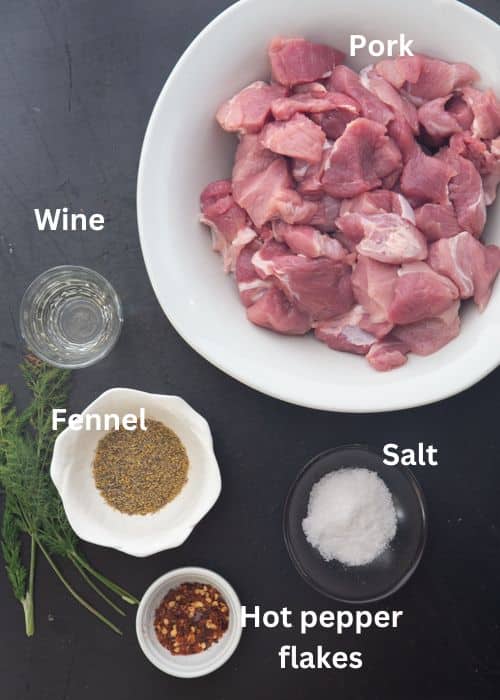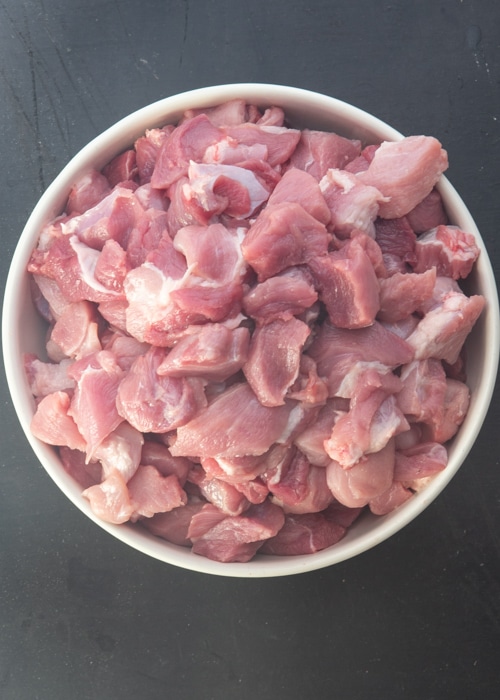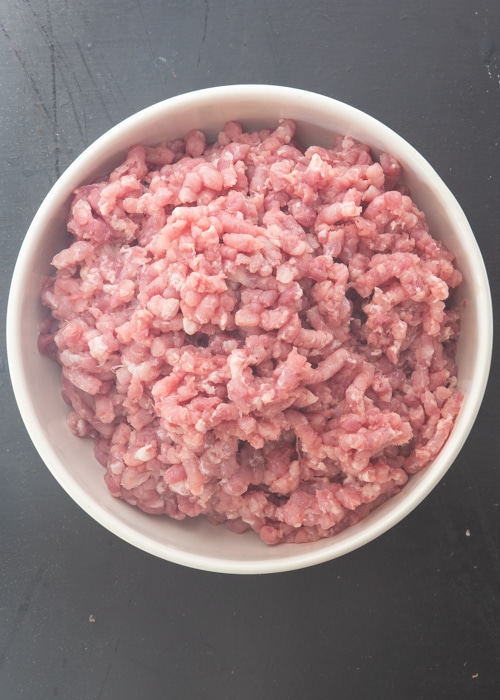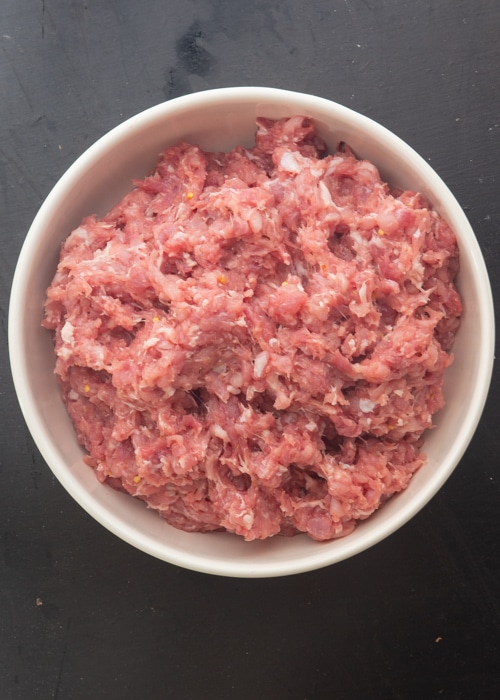Italian Homemade Sausage
Learn how to make Italian sausage right at home. It’s fresh, flavorful and tastes way better than store bought! It’s easier than you think and can be used in all your favorite recipes.

Italian sausage can be used in a variety of ways from a one pan veggie and sausage skillet to a sausage, cheese and mushroom strudel. Learning how to make Italian homemade sausage in your own kitchen just makes these recipes even more fresh and flavorful!
Homemade Italian sausage is essentially just ground pork with spices. It can range anywhere from a hot Italian sausage with red pepper flakes to a sweet Italian sausage that doesn’t contain any pepper.
Sausage can be used in a variety of different ways year round which makes it a popular cased protein! Use it on pizza either in slices or loose chunks, grill it and serve it on a bun at summer BBQ or add it to a hearty sauce like this white sauce lasagna.
This homemade sausage is so much better than store bought and since you can control what goes into it, it can be high quality good sausage without the higher price!
Italian Sausage Ingredients
- Pork: You will need at least 4¼ pounds pork. A trimmed pork shoulder or pork butt is preferred and if using pork shoulder make sure at least a ½ pound is pork fat.
- Salt: Salt adds flavor and acts as a preservative in this Italian homemade sausage.
- Pepper: Hot pepper flakes or cracked black pepper or a combination of the two depending on your spice preference.
- Fennel: Dried wild fennel (finocchietto) is preferred and will add the best flavor. Or you could substitute with fennel seeds.
- White wine: Adds additional aroma and flavor to the Italian homemade sausage. If you wouldn’t drink it, don’t add it. You could use a red wine such as Sangiovese or Chianti if preferred.

Variations
- Smaller links: I made links that were 4-5 inches but you can make smaller links if you would like.
- Use different seasonings: Common seasonings to use include fennel seeds, salt, black pepper, garlic, paprika, sage, parsley, cayenne or red pepper flakes. Try a few to find the combination you like!
- Drying times: Homemade Italian sausage needs to be dried at least 12 hours, if you plan to dry it longer, store it in a cool and airy place for about a month and you must add a total of 8-9 teaspoons of salt to the recipe.
- Ground sausage: Skip the casing and have fresh ground Italian sausage or breakfast sausage patties instead, use it instead of ground beef in this meat sauce and then serve over pasta for an easy dinner!

How to Make Italian Homemade Sausage
Making Italian sausage is easier than you think just follow these steps. First, you will need to chop your pork into small pieces.

Then using a meat grinder, grind the pork then place in a large bowl.

Add the salt, hot pepper flakes, dried fennel and white wine. I recommend using the minimal amount of spices first, then cooking a small amount and adjusting the seasonings to taste.

You could also combine the ground meat and spices with a stand mixer and the paddle attachment, a few turns on low speed should be enough.
Next, assemble your grinder with the casing, leaving at least 6 inches of casing off the end of the tube, this will be needed to tie it off later.
Now add your pork mixture to the stuffer. If all the meat doesn’t fit, just keep pushing it through, or you can stop half way and tie off the casing and continue with a second batch.
When the meat starts to come out, check to make sure that the casing does not slip off the tube and that the meat is filling the casing. Make sure the sausage comes out in a long tube, and the sausage links are tied off at the end.

When all the meat is in the casings, both ends should be tied off with tight double knots. Take a disinfected sewing needle and go up and down the casing piercing it with the needle.
Then using both hands, form the links every 4-5 inches making sure they are tight in the casing. Twirl the links a couple of times, continuing down the whole length of the coil.
Hang your Italian homemade sausage to dry without touching each other for at leat 12 hours before cooking it and consuming it.

What is finocchietto or wild fennel?
Wild fennel is an aromatic herb typical of the Mediterranean cuisine, in particular in Sicily. It can be replaced with the green leaves of a fennel, or with a teaspoon of fennel seeds which however have a more intense aroma.
Expert Tips
- Season and adjust as you go: Remember you can always add more seasoning to your Italian homemade sausage but you can’t take any added out!
- Casing: For casings you can use either synthetic collagen casings or ask your butcher if they sell hog casings, which are the scrubbed, salted intestines of a pig.
- Leave room to tie off the sausage: I recommend leaving at least 6 inches of casing off the end of the tube so you can easily tie it off after stuffing.
- Recruit a kitchen helper: It really helps the process go a bit more smoothly.
- Do not skip the drying time: Homemade sausage needs to be dried at least 12 hours.
- Make ahead: You can make homemade Italian sausage up to 3-4 days in advance. Just cover and refrigerate until ready to cook.
Recipes Using Italian Sausage
There are so many ways to use Italian homemade sausage, really the sky’s the limit! Here are a few favorite Italian sausage recipes. Buon Appetito!
- Italian baked meatballs
- Italian sausage and peppers
- Sausage and artichoke pizza
- Fresh tomatoes and sausage pasta
- Stuffed zucchini
- Lentil and sausage stew


Italian Homemade Sausage
Equipment
- 1 Meat grinder
- Kitchen scale
- Sausage casings
- Sausage stuffer
- Butcher's thin twine
Ingredients
- 4¼ pounds pork (pork shoulder make sure at least a ½ pound is fat)
- 5-7 teaspoons salt (if drying over a longer period add at least 8-9 teaspoons of salt)
- ½-1 teaspoon hot pepper flakes or black pepper or a combination
- ½-1 teaspoon dried wild fennel (finocchietto)*
- 2 tablespoons white wine
*You can substitute with fennel seeds, start with 1/2 a teaspoon.
Instructions
- Chop the pork into small pieces.
- Ground the pork with a meat grinder, then place in a large bowl, add the salt, hot pepper flakes, dried fennel and white wine. Add the lower amount of ingredients first. Then take a small amount (mini hamburger amount) and cook it, taste and adjust the seasonings to your liking. Remember you can add but you can't take away.
- Hook up your sausage stuffer with the casing, leave at least 6 inches of casing off the end of the tube, this is needed to tie off later.
- Stuff the meat mixture into the stuffer. If all the meat doesn't fit, just keep pushing it through, or you can stop half way and tie off the casing and continue with a second batch.
- When the meat starts to come out, check to make sure that the casing does not slip off the tube and that the meat is filling the casing, good idea to do it with a helper. Make sure the sausage comes out in a long tube, sausage links are tied off at the end. Be sure to leave 6 inches of casing on both ends.
- When all the meat is in the casings, both ends should be tied off with tight double knots. Take a sewing needle (disinfected) and go up and down the casing piercing it with the needle.
- Then with both hands, start forming the links, make sure they are tight in the casing, ours were about 4-5 inches, then twirl the link a couple of times, continue down the whole length of the coil, tie the sausages as shown in the photo.
- The sausages should be hung to dry in a cool area without touching each other for approximately 12 hours before consuming. Enjoy!
I love to make this recipe without casings. So I’m assuming I don’t need to dry it. Is that correct?
Hi Heidi, that is correct. I hope you enjoy them. Take care!
I am going to try this recipe next week. A couple of questions:
How many needle holes do you make? How far apart?
After drying for a month, do the sausages need to be cooked?
Hi Bob, I would say we made 8-10 holes in each sausage, yes after drying for a month they should be consumed. I hope you enjoy them. Take care.
Although I haven’t tried it yet I’m delighted to find a rather straightforward simple Italian sausage recipe. Many on the internet are spiced with the kitchen sink of herbs, none of which appeal to me or do I associate with good Italian sausage.
Hi Thomas, thanks so much, I hope you enjoy it. Be sure to let me know. Take care and have a great weekend!
Hi Rosemary, I love your web site. My question to you, I’m going to make your recipe for homemade Italian sausage. I love sausage in patties, do you let it dry in the bowl for 12 hours? I’m going to use my Momma and Daddys old hand grinder. I remember helping my Momma make Italian sausage when I was a kid. She always made it in bulk. She would help my grandpa make sausage and she hated the skins she said it was gross lol. She was the only one my grandpa would let help him so all the stuFf out in his shed/smoker . Thanks, Julia
Hi Julia Ann, thanks so much, glad you like the site. When I made them into patties, I didn’t let them dry, there really isn’t any need to. You could refrigerate the mixture for a few hours to bring the flavours together if you prefer. Let me know how it goes. Take care!